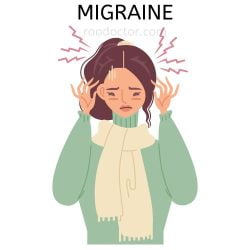

Listen to this Article
Listen to “Migraine Headaches” on Spreaker.Migraine headaches
There are so many types of headaches and one of them is Migraine. Migraines are so intense they leave you unable to think or function normally.
So, when the pain strikes, the last thing you want to be worrying about is how to deal with your headache. But migraines can be tricky and challenging, especially if you get them frequently.
What is it like to experience an attack?

Have you ever experienced a headache that feels like a vice has clamped down on your head? Or one that feels like someone is drilling into your brain? If yes, then it’s very likely that you have had a migraine attack.
They are not only extremely painful but also come with their own set of triggers and side effects.
If you have been recently diagnosed with migraines or notice that your occurrences have increased in frequency and intensity, read on for all the information about migraines and how to beat the pain.
I have recently published an article about headaches. You can read it here below if you have read it-
What Is a Migraine?
A migraine is a neurological disorder that affects people of all ages, genders, and ethnicities. It can cause extreme pain in the head and can even feel like an “exploding” sensation.
It can also lead to nausea and vomiting, sensitivity to light and sound, cognitive impairment, and even the feeling of being detached from reality.
Migraines typically last between 4 and 72 hours and can reoccur within the same week. There is no known cause, but certain factors can trigger an attack.
The pain and other symptoms of a migraine can be debilitating. An average migraine sufferer, if not treated, can experience symptoms on average about 13 times a month.
About 30% of migraine sufferers have auras, which are a series of visual disturbances that occur before the migraine hits. These auras usually subside within 30 minutes.
Types of migraine
There are many different types of migraine, and most people get at least two types during their lifetimes. The main difference between them is how long they last. Some last just a few hours, while others can last days or even weeks.
Migraines can be classified as follows –
- Classical Migraine: In this type of migraine, the entire head pains.
- Migraine with aura: This is the most common type of migraine and involves seeing flashing lights and/or spots before you experience a migraine. You can also experience numbness in your limbs or weakness in your muscles.
- Prodromal migraine: This is when you experience symptoms like fatigue, irritability, and restlessness before you feel a migraine coming on.
- Chronic migraine: These are migraine headaches that occur 15 or more times a month.
- Post-traumatic migraine: This occurs after a blow to the head or a jolt to the neck or spine that triggers a migraine.
- Menstrual migraine– occurs during Menstrual periods. The hormonal changes that happen in menstruation triggers the headache.
What causes migraine
Triggers to Expect and How to Deal with Them
- Hormonal Changes – During the menstrual cycle, migraine cases increase in severity. This is because of the drop in estrogen levels during the luteal phase of the cycle. –
- Weather – If you have a seasonal migraine, changes in the weather can trigger an attack.
- Stress and Sleep – Stress can exacerbate migraine symptoms, especially anxiousness and restlessness. Sleep deprivation can also trigger migraines. –
- Certain Foods – Some people experience migraines after eating certain foods, like chocolate, cheese, and red wine. For e.g.one of patients loves eating ice-cream, but it triggers her headache. She has been advised to avoid eating ice cream.
- Alcohol – Having one or two alcoholic drinks can actually help with migraines but having more can actually trigger an attack.
- Certain Medications – A variety of prescription medications can trigger migraines, including birth control, allergy medications, and antibiotics. Certain over-the-counter medications can also trigger migraines.
- Other Health Conditions – A number of health conditions can trigger migraines, including thyroid conditions, irritable bowel syndrome, epilepsy and hypertension.
Symptoms and signs of migraine-
Migraine is a common disorder that affects the head and neck. It can cause –
- severe headache that varies from involving the whole of head or only a part of the head
- nausea,
- vomiting,
- sensitivity to light, or
- vision changes.
This type of headache typically occurs once or twice a month over the course of 4-14 days. It can be triggered by many different things including physical and emotional stress
Treating migraine
A migraine attack can be treated in two ways-
- With medicines
- Without medicines
Let us first learn how to treat migraine without medicines –
- Stay hydrated – People who experience migraines with vomiting find that drinking a lot of water helps reduce the frequency of the attack.
- Stay in a dark, quiet room – Excessive noise and light can make the pain worse.
- Try a Cold compress – A cold compress on your forehead can help reduce the swelling in your brain that causes the pain.
- Meditate – Studies have shown that meditation can actually help reduce migraine pain.
- Have a cup of coffee. It contains caffeine that can help with some pain killer like naproxen or nimesulide
Take Your Painkillers –
Migraine is a common condition, affecting approximately one in five people globally at some point in their lives. It’s thought to be caused by an imbalance of chemicals in the brain and can be treated with drugs or lifestyle changes.
One of the most effective treatments for migraines is taking anti-inflammatory drugs, such as ibuprofen (Advil, Motrin) or naproxen (Aleve). These are short-term treatments that can help reduce the pain and inflammation that triggers a migraine. In some countries these are available over-the counter.
If you are one of the lucky people who experience relief from over-the-counter drugs, take them as soon as you start experiencing the pain. Usually, normal pain killers do not work in severe migraine headaches. To tackle that pain, you have to have anti- migraine tablets [ see below]
Migraine medications-
If the above medications don’t work, there are anti-migraine drugs available to reverse migraines. Your doctor may recommend other types of drug treatment, such as triptans or antidepressants.
These are as follows-
- Sumatriptan- e.g., Suminat Fast 25, Sumisun 25, Sumitrex 25. Dosage- as suggested by your doctor. [ This medicine is also available as a nasal spray for quick relief, e.g., Suminat Nasal spray. Here again, your doctor can suggest to you as to how many times you can use it]
- Ergot amines- e.g., Migranil EC. This medicine is a combination of ergotamine and caffeine
- Beta blockers- e.g. Propranolol like Ciplar LA [ 20/40] mg.
- Anti-depressant like amitriptyline e.g. Tryptomer 10mg.
All these drugs used with the usual pain killers can help relieve the pain of migraine effectively. However, you should consult your doctor as these drugs have many side effects. Your doctor will be the right person to advise you on the best line of treatment. In case you have been prescribed any of these medicines, you can get it online here- TATA 1mg.
Long Term and Effective Ways to Beat the Pain of Migraine
In my day-to-day practice, I find treating and later preventing migraine in my patients quite challenging. However, I try my best in relieving the initial pain of the headache and later on, I give the following advice-
- Examine Your Diet – If you suffer from migraines, you may be sensitive to certain foods. Avoiding these foods can help reduce the number of headaches you get.
- Exercise – Exercise can help reduce the frequency of migraines and the amount you suffer from them.
- Get enough sleep – Sleep deprivation can actually trigger migraines, so aim for 7-8 hours each night.
- Find a Trigger – If you are experiencing a lot of migraines, try to identify what could be causing them. Once you have found the trigger, you can try to avoid it.
- Avoid Stress – Stress can trigger migraines, so find ways to de-stress.
- Have a cup of strong filtered coffee– coffee has beneficial effects on the brain center that triggers an attack
- Flunarizine is one drug that I recommend to my patients who get repeated attacks of migraine. Given in a dose of one 10mg tablet at night for about one month can prevent attacks for up to 6 months in some patients.
Conclusion
Migraines can be debilitating and severely impact your life. However, there are ways to manage them and reduce their frequency and intensity.
By examining your diet, exercising, getting enough sleep, and finding ways to reduce stress, you can reduce your risk of migraines.
And when they do strike, take your painkillers, stay hydrated, stay in a dark, quiet room, and use a cold compress to reduce the pain.
In my subsequent article, I will be discussing another type of head pain, Tension Headache. Do stay tuned in till then.
Adios.
Disclosure: –
This article contains links that pay a small commission to the author on clicking and purchasing an item without any extra charge to the purchaser.
Useful resources
Share Your Experience
Finally, I would be incredibly happy if you could leave a brief review of your experience about this article- whether this blog was helpful to you or there was something missing and you would like me to add it in my future updates to this article. Alternately, you can also subscribe to my newsletter, so that you get the latest news of any articles published in the future. Thank you. You can submit your review below–

